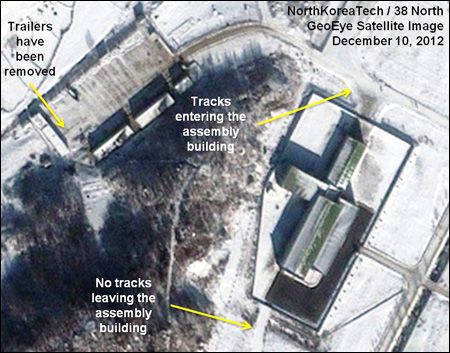
North Korean rocket technology progressing

There appears to be a new North Korean satellite lurking in orbit. The real statement out of Pyongyang was how its rocket achieved the desired height and speed, according to the head of South Korea’s space agency.
Whether the intention is to boost its long-range weaponry or jump into the Asian space race, the Unha-3 launch indicates significant progress in skills and engineering capabilities, said Kim Seung-jo, president of the Daejeon-based Korea Aerospace Research Institute (KARI). The core of international concern is that the country one day will own a nuclear warhead capable of hitting targets as far away as the United States.
“North Korea has been relying on technology used by the Russians and Americans in the late-1950s, ‘60s and ‘70s. It is the same rocket that blew up prematurely in April, but I think that their concentrated and persistent efforts paid off this time,’’ said Kim in a telephone conversation.
“While conventional liquid fuel rockets aren’t regarded for use as missiles considering the time it takes to fill them and the short window for launch, the current North Korean rocket is different because it used unsymmetrical dimethylhydrazine (UDMH) as fuel and nitric acid as oxidizer.
“UDMH retains a high stability at elevated temperatures, so it can be kept in rockets for an extended period. The rocket could be pretty much launched anytime within that period. Nitric acid-UDMH rocket engines were commonly used in old Russian models like the SS18 and SS19, which were developed as missiles.’’
At the time of going to press, North Korea was claiming its rocket launch was a success, with its payload, a weather satellite, delivered into orbit, and military officials in the South were admitting that could be true.
The previous launch of the three-stage Unha-3 in April ended in failure after the rocket exploded shortly after its take-off from northwest North Korea. The rocket seems essentially a variation of the Taepodong-2 missile launched in 2006. It could be that the country has simply settled on a standard design and continues to test it, according to rocket analysts here.
Rockets are one of the few areas where the North could claim supremacy over the South. It’s been nearly two years since the Korea Space Launch Vehicle-1 (KSLV-1) exploded moments after take-off and spun South Korea’s aspirations to join the space-launch industry further out of orbit.
That represented the country’s second major space setback in the span of less than a year, triggering a verbal dispute between KARI and its Russian technology providers over who was to blame and thus should take the lion’s share of the cost for the third launch.
The Koreans and Russians eventually managed to schedule a third attempt earlier this month, but the launch was aborted due to technical failures exposed during the countdown.
Ironically, South Korea may use a similar rocket to the Unha-3 to launch its own satellite. Kim confirmed that the launch vehicle for the Arirang-5, planned to be launched in Russia last year, is expected to be a remodeled SS18.
Tak Min-jae, an aerospace scientist at the Korea Advanced Institute of Science and Technology (KAIST), assumed it would take South Korea five to seven years to achieve the level of technology used in Unha-3.
“Considering the locations where the first and second stage of the rockets dropped, it seems indeed that North Korea has acquired a vehicle to wreak havoc. The Nodong missiles were already capable of reaching Japan and now they may have a rocket that could hit the United States,’’ said Tak, who finds many similarities between the Unha-3 and China’s Long March 1 fired in 1970.
“Of course, shrinking nuclear warheads to a size acceptable as payload would require a serious jump in nuclear physics ― no rocket will be capable of carrying a 1-ton warhead ― and poses a much tougher challenge. The goal would be to develop a warhead weighing around 500 kilograms or lighter. The North Koreans will continue to advance their efforts to build larger launch vehicles as well,’’ he said.
Tak believes that North Korea is developing its current rockets based on the Chinese three-stage models used in the 1970s. These rockets were built around a massive first stage with four liquid-fuel engines, an additional liquid-fuel engine in the second stage, and a payload-controlling third-stage that was powered by either liquid or solid fuel.
“Liquid-fuel missiles were quite common as seen in the V2s, older rockets from Russian and China, and even Scuds. North Koreans been consistently developing rockets since the 1970s and they appear to be reaping the fruits of their four decades of effort,’’ he said. <The Korea Times/Kim Tong-hyung>



